|
|
|
|
No
1 |
|

|
|
|
January,
2001, completion of the new classroom in the
right |
|
Imagine. You are on the journey along an endless
rural road. Rain trees thrive on the both sides to make
the border in the huge expansion of paddy fields. At
times a hen crosses the road in a hurry in front of
the car. Overloaded rickshaws go slowly.
All of a sudden a small white building appears in the
green paddies, and that is the very first building-like
building you see in the surroundings. It seems to be
an entrance to a fairy land, inviting you in the green
breeze. Narayanpur village school is there. As soon
as we arrive, the children and the people surge from
somewhere to invite us to a new world where there is
no worldly traffic access.
The Narayanpur Village had a private primary school.
It started from a shed by the village volunteers. Since
the place was his grandfather’s land, the former Bangladesh
Ambassador to Japan, Mr. AKM.H. Huq helped the school
financially by appealing to some Japanese societies.
He retired from his public life and went back to his
motherland with the resolution to serve for the nation’s
development for the rest of his life. He continued to
appeal to Japanese organizations for financial help.
In 1998, SRID (Society of Researchers of International
Development) Women’s Club agreed to his activities and
contributed a classroom. The village people managed
to offer their labor between the field work to make
the utmost use of the donated money, which enabled to
purchase new desks, benches, refurbishment and even
fifty books. They even re-painted the building white
to be “brand-new” inside and outside. The whole process
required nearly two years. When the building was completed,
two teachers of mathematics and English were hired by
the private money from Professor Kazuko Saito. She funded
the two teachers’ salary for three years. Upon her retirement,
the program was succeeded to SRID Women’s Club from
September, 2005. There came about twenty applicants
for the two positions of English and mathematics teachers.
For this employment and the support, the village became
famous as a “Japan Village” in the rural region, and
the people, especially the unemployed, tried to see
hope in the project. Thanks to the additional teachers,
the village school proudly produces a few excellent
students who can win government scholarship for advanced
education every year.
From 2005 Sakura Mohila, Japan employed a music teacher
for the children. He gives the children good music education
and they can play the instruments and sing English songs
as well as their national songs.
If you have time, go through that endlessly continued
rain tree road until you see the white building. You
will see, while you are wrapped up with the singing
voices, “If all the children in the world laugh, the
sky will also laugh. If all the children in the world
sing, the sky will also sing…..” See the picture of
the children. They have two meals a day and are always
hungry, in fact. |
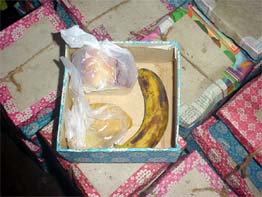 March, 2006,
March, 2006,
a box of snack for the children |
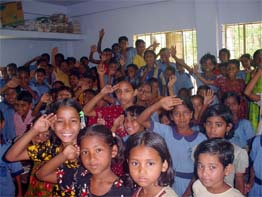 in the classroom,
in the classroom,
getting together for the concert |
|
The school has a harmonium, two sets of drums and
160 ocarinas. They will have another set of drum this
spring. With the change to the public school, they do
not use slates any more, but use notebooks. It is a
story of the year, 2005. |
|
 |
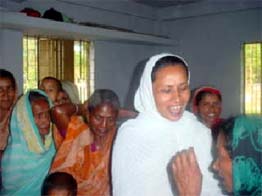 The shomity leader
The shomity leader |
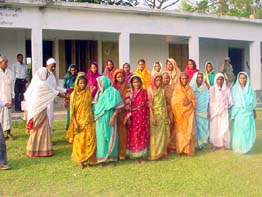 the shomity women
the shomity women |
|
| In March, 2003, when there was some money, a program
was added. The village women in their 40s who have “no
land, no house or no husband” were called to organize
a “shomity” or a community. Mr. Huq named it “Sakura
Mohila” shomity, being in his seventh heaven. Sakura
is the Japanese symbol flower and mohila means a woman
in Bengali. The twenty-seven women of the shomity chose
their leader. The leader lady has husband, a house and
land in addition to strong leadership. Under her leadership,
they began to save a little money every week when they
got together at the leader’s house after work to learn
reading and writing together with some social studies
such as to stop the custom of dowry. The preparation
was finished after one and a half years with the saved
assurance money, and the seed money was offered by 3%
interest on a loan. The leader took all the care of
the management by the salary from Japan. Some women
bought cows, goats or chickens to start their own jobs,
and others bought air tickets for their daughters and
sons to work out in Saudi Arabia. They take advantage
of the low interest and the project works well for the
welfare of the Sakura Mohila Shomity women.
In September, 2005, a Japanese woman contributed money
for four sewing machines, instructor’s salary and rent
for the work place. The women learned how to use the
machines for nearly half a year and for the first time
in the life they began to make bags out of saris for
commercial purposes. Sakura Mohila Trading ordered the
goods as its package bags. The bags are so beautiful
and exotic and they have received additional orders
from Japan. The bags are also sold as independent goods
as well as the package bags.
The saris are bought in Dhaka and brought to the village
by Hossain who is a relative with Mr Huq When the bags
are made, he again brings to Dhaka. And the bags are
checked and shipped out from there to Japan. |
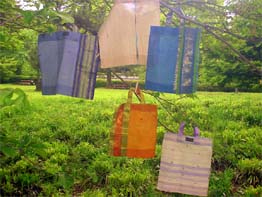 Sari bags, large and small sizes
Sari bags, large and small sizes |
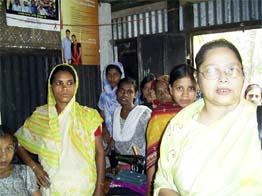 the village women with a sewing machine
the village women with a sewing machine |
|
| Gradually the village women will make other small things
to sell in Japan. You will see what will come out in the
future. |
|
 |
Sakura Mohila Trading was established to fund the village
project in 2003. It sells Bangladeshi silk dresses in
Japan. It has a designer who designs for the Japanese
ladies and Bangladeshi tailors make according to the patterns
under the instruction and training. Lately as there appear
good linen and cotton in the market, it is beginning to
use them to add variety of clothing style to the silk.
The practice of the past three and half years was not
easy. The training began with measuring, because tailors
made variety of sizes from one pattern. Three years of
the training seems to put light on the project, when money
appropriation happened on the Bangladesh side. Sakura
Mohila Trading began to take on a new course to go on,
despite the disappointment. It began to ask a big business
to make according to the design by Sakura Mohila Trading,
as well as asking cooperation to another private tailor
for personal orders. So far, the big business can provide
Sakura Mohila Trading with handwork of traditional embroidery
and so on by the women and the handicapped.
Sakura Mohila Trading holds an “Exhibition & Sale”
twice a year in June and January at a cafe gallery “SHINE”
in front of YONO station, Keihin-Tohoku line. But it will
become possible to increase the opportunities to show
the goods on consignment in some more places. If you know
any good place for us to show our goods, you can be a
person who will give another opportunity to the Narayanpur
village people.
Your mail is most welcomed at: sakura_mohila@yahoo.co.jp |
|
|













